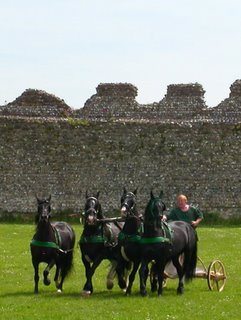
Right: Quadriga and Roman Wall, Porchester, Hampshire
You probably thought there were no Romans left in Britain, but there were dozens of them running around Porchester on Sunday, and the proof is in the photograph (More are available via the link to photos at the right). Members of three Romano-British re-enactment groups – the Ermine Street Guard, Britannia, and ERA (End of the Roman Age) turned out in force and fancy-dress for English Heritage’s Roman Festival held there over the weekend. They fired ballistae, ran one another through with swords and spears, and demonstrated Britain’s first reproduction of a Roman racing chariot, here driven by Tony Smart, who provides horses and his riding skills for films and TV.
The four-horse racing chariot, or quadriga, was donated to English Heritage by Time Team, a popular archaeology show on British TV. The show’s archaeologists had excavated a chariot-racing track, and subsequently commissioned the reproduction of a chariot to run on it. Although no hard evidence had been found before last year , it had been long surmised that there must have been chariot racing in Britain during Roman rule. Chariot racing was bigger than football, bigger than lions eating Christians, bigger than anything in Roman entertainment. Chariot racers, who seldom saw the far side of 30, were celebrities on a scale we can scarcely imagine unless we envision David Beckham being canonized after winning the Nobel Prize. The most famous chariot-racing riot in history resulted in 30,000 deaths, which makes a football riot seem like a few of the lads messing about after a match.
Three more quadrigae are being built, and next year’s festival will feature a race among the four famous Roman racing factions: the Blues, the Greens, the Reds, and the Whites. Perhaps English Heritage can organize modern Britain’s first chariot-racing riot, and if that doesn’t sell admissions, I don’t know what would.
Dev Agarwal had kindly agreed to chase Romans with me again, and we drove down to Hampshire (Jane Austen Country) on England’s south coast Sunday morning and spent the hottest day of the year to date watching demonstrations of battle tactics, sword- and spearplay, and Roman field surgery. I cannot imagine running around in armor, helmets, and in some cases bearskins, as these hardy re-enactors did, and they did it with smiles on their faces. There’s a photo of Dev looking remarkably cool in the ruins of Porchester Castle among the other “best-of” shots of the day – just follow the photo link at right. After collecting sunburns and souvenirs (I found the perfect desk accessory for you, Mr Dougie), we battled traffic back to Whitton and had coffee and dessert with Terri and Rani before I headed for home, nicely satiated with conquerors and tiramisu, to spend the evening reading slush. I would dearly love to be back next year for the big race.





2 comments:
Roman traces are everywhere in England, and they end up on this side of the Pond as well. I live in Rochester, New York, named after Rochester, England. The word 'Rochester', as with all the '-chester' and '-caster' place names in England, originated with the name of a Roman military camp or settlement. The Latin word for 'camp' is 'castra'.
Check out Alec Gill's Website for some neat stuff on the English language and its history, among other things.
I can show you the American version of chariot racing. It happens in the Western part of the United States in the months of December through March. The world cutter and chariot racing finals happen two week-ends in March every year. The two horse teams run three teams abreast for 440 yards. See some race pictures and a little Cutter Racing history Here
Post a Comment